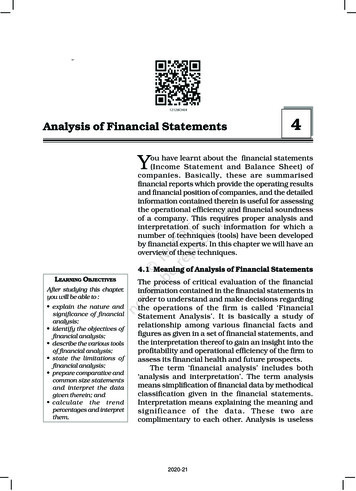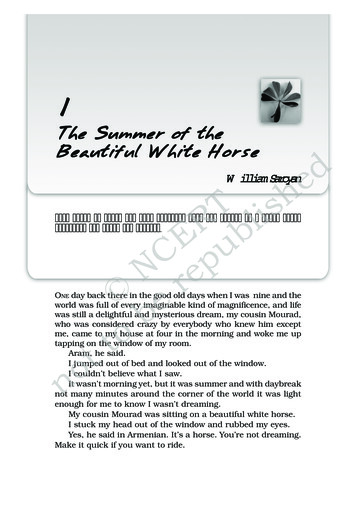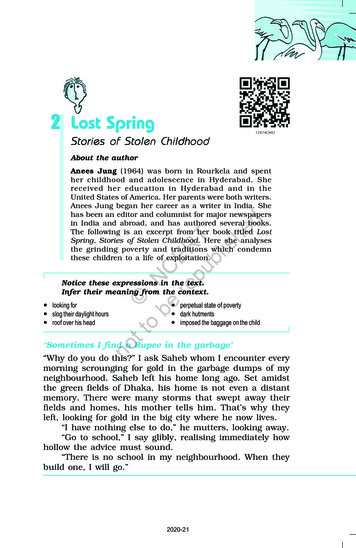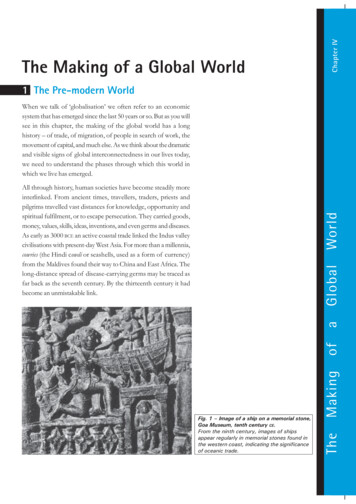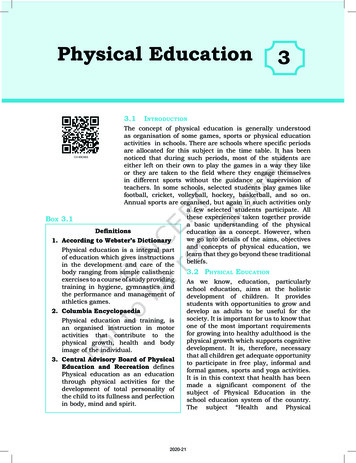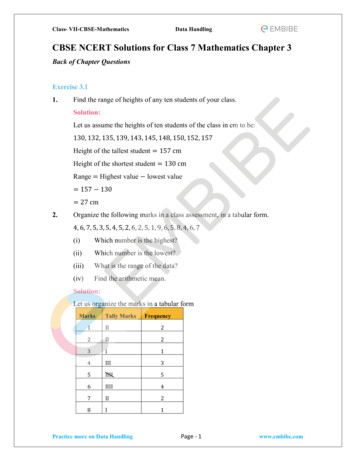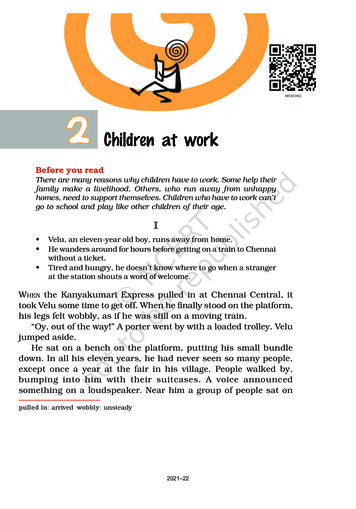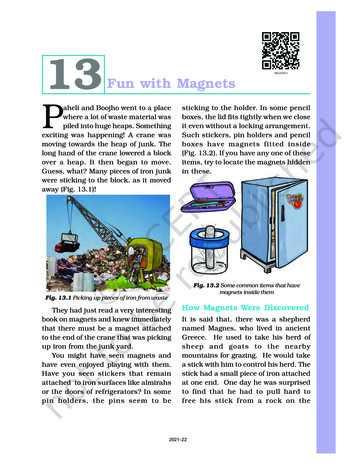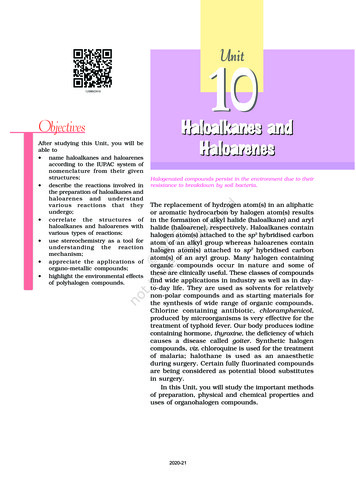
Transcription
Unit10ObjectivesAfter studying this Unit, you will beable to name haloalkanes and haloarenesaccording to the IUPAC system ofnomenclature from their givenstructures; describe the reactions involved inthe preparation of haloalkanes andhaloarenes and understandvarious reactions that theyundergo; correlate the structures ofhaloalkanes and haloarenes withvarious types of reactions; use stereochemistry as a tool forunderstanding the reactionmechanism; appreciate the applications oforgano-metallic compounds; highlight the environmental effectsof polyhalogen compounds.Haloalkanes andHaloarenesHaloarenesHalogenated compounds persist in the environment due to theirresistance to breakdown by soil bacteria.The replacement of hydrogen atom(s) in an aliphaticor aromatic hydrocarbon by halogen atom(s) resultsin the formation of alkyl halide (haloalkane) and arylhalide (haloarene), respectively. Haloalkanes containhalogen atom(s) attached to the sp3 hybridised carbonatom of an alkyl group whereas haloarenes containhalogen atom(s) attached to sp2 hybridised carbonatom(s) of an aryl group. Many halogen containingorganic compounds occur in nature and some ofthese are clinically useful. These classes of compoundsfind wide applications in industry as well as in dayto-day life. They are used as solvents for relativelynon-polar compounds and as starting materials forthe synthesis of wide range of organic compounds.Chlorine containing antibiotic, chloramphenicol,produced by microorganisms is very effective for thetreatment of typhoid fever. Our body produces iodinecontaining hormone, thyroxine, the deficiency of whichcauses a disease called goiter. Synthetic halogencompounds, viz. chloroquine is used for the treatmentof malaria; halothane is used as an anaestheticduring surgery. Certain fully fluorinated compoundsare being considered as potential blood substitutesin surgery.In this Unit, you will study the important methodsof preparation, physical and chemical properties anduses of organohalogen compounds.2020-21
10.1 ClassificationHaloalkanes and haloarenes may be classified as follows:10.1.1 On theBasis ofNumber ofHalogenAtomsThese may be classified as mono, di, or polyhalogen (tri-,tetra-, etc.)compounds depending on whether they contain one, two or more halogenatoms in their structures. For example,Monohalocompounds may further be classified according to thehybridisation of the carbon atom to which the halogen is bonded, asdiscussed below.10.1.2 CompoundsContainingsp3 C—XBond (X F,Cl, Br, I)This class includes(a) Alkyl halides or haloalkanes (R—X)In alkyl halides, the halogen atom is bonded to an alkyl group (R).They form a homologous series represented by CnH2n 1X. They arefurther classified as primary, secondary or tertiary according to thenature of carbon to which halogen is attached. If halogen is attached toa primary carbon atom in an alkyl halide, the alkyl halide is calledprimary alkyl halide or 1 alkyl halide. Similarly, if halogen is attachedto secondary or tertiary carbon atom, the alkyl halide is calledsecondary alkyl halide (2 ) and tertiary (3 ) alkyl halide, respectively.(b) Allylic halidesThese are the compounds in which the halogen atom is bonded to ansp3-hybridised carbon atom adjacent to carbon-carbon double bond(C C) i.e. to an allylic carbon.Allylic carbonAllylic carbon(c) Benzylic halidesThese are the compounds in which the halogen atom is bonded to ansp3-hybridised carbon atom attached to an aromatic ring.Chemistry 2902020-21
10.1.3 CompoundsContainingsp2 C—XBondThis class includes:(a) Vinylic halidesThese are the compounds in which the halogen atom is bonded toa sp2-hybridised carbon atom of a carbon-carbon double bond(C C).(b) Aryl halidesThese are the compounds in which the halogen atom is directlybonded to the sp2-hybridised carbon atom of an aromatic ring.10.2 NomenclatureHaving learnt the classification of halogenated compounds, let us now learnhow these are named. The common names of alkyl halides are derived bynaming the alkyl group followed by the name of halide. In the IUPAC systemof nomenclature, alkyl halides are named as halosubstituted hydrocarbons.For mono halogen substituted derivatives of benzene, common and IUPACnames are the same. For dihalogen derivatives, the prefixes o-, m-, p- areused in common system but in IUPAC system, as you have learnt in ClassXI, Unit 12, the numerals 1,2; 1,3 and 1,4 are used.The dihaloalkanes having the same type of halogen atoms are namedas alkylidene or alkylene dihalides. The dihalo-compounds having boththe halogen atoms are further classified as geminal halides or gem-dihalideswhen both the halogen atoms are present on the same carbon atom of the291 Haloalkanes and Haloarenes2020-21
chain and vicinal halides or vic-dihalides when halogen atoms are presenton adjacent carbon atoms. In common name system, gem-dihalides arenamed as alkylidene halides and vic-dihalides are named as alkylenedihalides. In IUPAC system, they are named as dihaloalkanes.Some common examples of halocompounds are mentioned in Table 10.1.Table 10.1: Common and IUPAC Names of some HalidesStructureCommon nameIUPAC nameCH3CH2CH(Cl)CH3 sec-Butyl chloride2-Chlorobutane(CH3)3CCH2Brneo-Pentyl tyl bromide2-Bromo-2-methylpropaneCH2 CHClVinyl chlorideChloroetheneCH2 CHCH2BrAllyl hylbenzeneor2-ChlorotolueneBenzyl chlorideChlorophenylmethaneCH2Cl2Methylene haneCHBr3BromoformTribromomethaneCCl4Carbon tetrachloride TetrachloromethaneCH3CH2CH2Fn-Propyl fluoride1-FluoropropaneExample 10.1 Draw the structures of all the eight structural isomers that have themolecular formula C5H11Br. Name each isomer according to IUPAC systemand classify them as primary, secondary or tertiary bromide.Solution CH3(CH3)2CHCH2CH2Br1-Bromopentane (1o)2-Bromopentane(2o)3-Bromopentane (2o)1-Bromo-3-methylbutane (1o)Chemistry 2922020-21
H3)3CCH2Bro2-Bromo-3-methylbutane(2 )o2-Bromo-2-methylbutane (3 )o1-Bromo-2-methylbutane(1 )o1-Bromo-2,2-dimethylpropane (1 )Write IUPAC names of the following:Example 10.2(i) 4-Bromopent-2-ene(ii) 3-Bromo-2-methylbut-1-ene(iii) 4-Bromo-3-methylpent-2-ene (iv) 1-Bromo-2-methylbut-2-ene(v) 1-Bromobut-2-ene(vi) 3-Bromo-2-methylpropeneSolutionIntext Question10.1 Write structures of the following compounds:(i) 2-Chloro-3-methylpentane(ii) 1-Chloro-4-ethylcyclohexane(iii) 4-tert. Butyl-3-iodoheptane(iv) 1,4-Dibromobut-2-ene(v) 1-Bromo-4-sec. butyl-2-methylbenzene.1 0 . 3 Nature ofC-X BondHalogen atoms are more electronegative than carbon, therefore,carbon-halogen bond of alkyl halide is polarised; the carbon atom bearsa partial positive charge whereas the halogen atom bears a partialnegative charge.As we go down the group in the periodic table, the size of halogenatom increases. Fluorine atom is the smallest and iodine atom is thelargest. Consequently the carbon-halogen bond length also increasesfrom C—F to C—I. Some typical bond lengths, bond enthalpies anddipole moments are given in Table 10.2.Alkyl halides are best prepared from alcohols, which are easily accessible.293 Haloalkanes and Haloarenes2020-21
Table 10.2: Carbon-Halogen (C—X) Bond Lengths, BondEnthalpies and Dipole MomentsBondBond length/pmC-X Bond enthalpies/ kJmol-1Dipole moment/DebyeCH3–F1394521.847CH3– Cl1783511.860CH 3–Br1932931.830CH3–I2142341.63610.4 Methods ofPreparationof Haloalkanes10.4.1 From AlcoholsThe hydroxyl group of an alcohol is replaced by halogen on reaction withconcentrated halogen acids, phosphorus halides or thionyl chloride.Thionyl chloride is preferred because in this reaction alkyl halide is formedalong with gases SO2 and HCl. The two gaseous products are escapable,hence, the reaction gives pure alkyl halides. The reactions of primary andsecondary alcohols with HCl require the presence of a catalyst, ZnCl2.With tertiary alcohols, the reaction is conducted by simply shaking thealcohol with concentrated HCl at room temperature. Constant boilingwith HBr (48%) is used for preparing alkyl bromide. Good yields ofR—I may be obtained by heating alcohols with sodium or potassiumiodide in 95% orthophosphoric acid. The order of reactivity of alcoholswith a given haloacid is 3 2 1 . Phosphorus tribromide and triiodideare usually generated in situ (produced in the reaction mixture) by thereaction of red phosphorus with bromine and iodine respectively.The preparation of alkyl chloride is carried out either by passingdry hydrogen chloride gas through a solution of alcohol or by heatinga mixture of alcohol and concentrated aqueous halogen acid.The above methods are not applicable for the preparation of arylhalides because the carbon-oxygen bond in phenols has a partial doublebond character and is difficult to break being stronger than a singlebond (Unit 11, Class XI).10.4.2 FromHydrocarbons(I) From alkanes by free radical halogenationFree radical chlorination or bromination of alkanes gives a complexmixture of isomeric mono- and polyhaloalkanes, which is difficult toChemistry 2942020-21
separate as pure compounds. Consequently, the yield of any singlecompound is low (Unit 13, Class XI).(II) From alkenes(i) Addition of hydrogen halides: An alkene is converted tocorresponding alkyl halide by reaction with hydrogen chloride,hydrogen bromide or hydrogen iodide.Propene yields two products, however only one predominates asper Markovnikov’s rule. (Unit 13, Class XI)(ii) Addition of halogens: In the laboratory, addition of bromine inCCl4 to an alkene resulting in discharge of reddish brown colourof bromine constitutes an important method for the detection ofdouble bond in a molecule. The addition results in the synthesisof vic-dibromides, which are colourless (Unit 13, Class XI).Identify all the possible monochloro structural isomers expected to beformed on free radical monochlorination of (CH3)2CHCH2CH3.Example 10.3In the given molecule, there are four different types of hydrogen atoms.Replacement of these hydrogen atoms will give the (CH3)2C(Cl)CH2CH3CH3CH(CH2Cl)CH2CH310.4.3 HalogenExchangeAlkyl iodides are often prepared by the reaction of alkyl chlorides/bromides with NaI in dry acetone. This reaction is known as Finkelsteinreaction.NaCl or NaBr thus formed is precipitated in dry acetone. It facilitatesthe forward reaction according to Le Chatelier’s Principle.The synthesis of alkyl fluorides is best accomplished by heating analkyl chloride/bromide in the presence of a metallic fluoride such as295 Haloalkanes and Haloarenes2020-21
AgF, Hg2F2, CoF2 or SbF3. The reaction is termed as Swarts reaction.10.5 Preparation ofHaloarenes(i) From hydrocarbons by electrophilic substitutionAryl chlorides and bromides can be easily prepared by electrophilicsubstitution of arenes with chlorine and bromine respectively in thepresence of Lewis acid catalysts like iron or iron(III) chloride.The ortho and para isomers can be easily separated due to largedifference in their melting points. Reactions with iodine are reversiblein nature and require the presence of an oxidising agent (HNO3,HIO4) to oxidise the HI formed during iodination. Fluoro compoundsare not prepared by this method due to high reactivity of fluorine.(ii) From amines by Sandmeyer’s reactionWhen a primary aromatic amine, dissolved or suspended in coldaqueous mineral acid, is treated with sodium nitrite, a diazoniumsalt is formed (Unit 13, Class XII). Mixing the solution of freshlyprepared diazonium salt with cuprous chloride or cuprousbromide results in the replacement of the diazonium groupby –Cl or –Br.Replacement of the diazonium group by iodine does not require thepresence of cuprous halide and is done simply by shaking the diazoniumsalt with potassium iodide.Chemistry 2962020-21
Example 10.4Write the products of the following reactions:SolutionIntext Questions10.2 Why is sulphuric acid not used during the reaction of alcohols with KI?10.3 Write structures of different dihalogen derivatives of propane.10.4 Among the isomeric alkanes of molecular formula C5H12, identify the one thaton photochemical chlorination yields(i) A single monochloride.(ii) Three isomeric monochlorides.(iii) Four isomeric monochlorides.10.5 Draw the structures of major monohalo products in each of the followingreactions:10.6 PhysicalPropertiesAlkyl halides are colourless when pure. However, bromides and iodidesdevelop colour when exposed to light. Many volatile halogen compoundshave sweet smell.297 Haloalkanes and Haloarenes2020-21
Melting and boiling pointsMethyl chloride, methyl bromide, ethyl chloride and somechlorofluoromethanes are gases at room temperature. Higher membersare liquids or solids. As we have already learnt, molecules of organichalogen compounds are generally polar. Due to greater polarity as wellas higher molecular mass as compared to the parent hydrocarbon, theintermolecular forces of attraction (dipole-dipole and van der Waals)are stronger in the halogen derivatives. That is why the boiling pointsof chlorides, bromides and iodides are considerably higher than thoseof the hydrocarbons of comparable molecular mass.The attractions get stronger as the molecules get bigger in size andhave more electrons. The pattern of variation of boiling points of differenthalides is depicted in Fig. 10.1. For the same alkyl group, the boilingpoints of alkyl halides decrease in the order: RI RBr RCl RF. Thisis because with the increase in size and mass of halogen atom, themagnitude of van der Waal forces increases.Fig. 10.1: Comparison of boiling points of some alkyl halidesThe boiling points of isomeric haloalkanes decrease with increasein branching (Unit 12, Class XI). For example, 2-bromo-2methylpropane has the lowest boiling point among the three isomers.Boiling point
Chemistry 294 10.4.2 From Hydrocarbons Bond Bond length/pmC-X Bond enthalpies/ kJmol-1 Dipole moment/Debye CH 3 –F 139 452 1.847 CH 3 – Cl 178 351 1.860 CH 3 –Br 193 293 1.830




